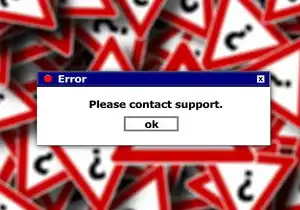IIS (Internet Information Services) is a powerful web server software developed by Microsoft for hosting websites and web applications. However, like any complex system, it can encounter errors that prevent your website from functioning correctly. One of the most common errors you might encounter with IIS is the "500 Internal Server Error." This error message indicates that an unexpected condition was encountered on the server, preventing it from fulfilling the request.
In this comprehensive guide, we will explore the various causes of the 500 internal server error in IIS, provide detailed troubleshooting steps to identify and resolve these issues, and offer best practices to minimize the occurrence of such errors in the future.

图片来源于网络,如有侵权联系删除
Understanding the 500 Internal Server Error
The 500 internal server error is a generic HTTP status code indicating that something has gone wrong on the server side. It's a catch-all error message used when the server cannot determine exactly what went wrong. While this error provides little specific information about the problem, it serves as a starting point for troubleshooting.
Common Causes of the 500 Internal Server Error
- Misconfigured Server Settings: Incorrect settings in the IIS configuration files or application pools can lead to server errors.
- Application Errors: Bugs or coding errors within your web application can cause the server to crash or behave unexpectedly.
- Resource Limitations: Exceeding server resource limits, such as memory or CPU usage, can result in a 500 error.
- File Permissions Issues: Incorrect file permissions on critical system files or directories can cause the server to fail.
- Corrupted Files: Damaged or corrupted DLL files, ASP.NET assemblies, or other essential components can trigger a 500 error.
- Security Misconfigurations: Inadequate security configurations, including incorrect authentication methods or overly restrictive access controls, can also lead to server errors.
- Database Connectivity Problems: If your application relies heavily on database connections, issues such as timeouts or connection failures can result in a 500 error.
Step-by-Step Troubleshooting Guide
Step 1: Check Server Logs
The first step in troubleshooting a 500 internal server error is to examine the server logs. The logs contain valuable information about the error, including the date and time of the error, the type of error, and the URL that caused it. You can find the logs in the following locations:
- For Windows Server 2019/2016:
%SystemRoot%\System32\logfiles\W3SVC1 - For Windows Server 2008/R2:
%SystemDrive%\inetpub\logs\LogFiles\W3SVC1
By analyzing the log entries, you may gain insights into the root cause of the error.
Step 2: Review Application Pool Settings
Incorrectly configured application pool settings can often lead to 500 errors. Ensure that the application pool identity has sufficient privileges to access all necessary resources. Additionally, verify that the application pool recycling settings are appropriate for your application's requirements.
Step 3: Inspect Web.config Files
Web.config files contain configuration settings for your web application. Look for any syntax errors, missing tags, or conflicting settings that could be causing the issue. Pay special attention to sections related to security, session state, and custom errors.
Step 4: Test with a Clean Environment
If possible, try reproducing the error in a clean environment. This involves creating a fresh virtual machine or container with minimal installed software and then deploying your application. This approach helps isolate whether the issue is specific to your production environment or a more general problem with your application.

图片来源于网络,如有侵权联系删除
Step 5: Update Software Components
Ensure that all software components, including IIS, .NET Framework, and any third-party libraries, are up-to-date. Outdated components can introduce compatibility issues and vulnerabilities that may lead to server errors.
Step 6: Monitor Resource Usage
Use performance monitoring tools to track resource utilization on your server. High memory consumption, CPU spikes, or disk I/O bottlenecks can all contribute to a 500 internal server error. Adjust resource allocations accordingly to prevent resource exhaustion.
Step 7: Implement Proper Security Practices
Review your security configurations to ensure they align with best practices. This includes using secure protocols (e.g., HTTPS), implementing proper authentication mechanisms, and configuring firewalls and intrusion detection systems effectively.
Step 8: Consult Documentation and Community Forums
Microsoft documentation and community forums like Stack Overflow can be invaluable resources for resolving IIS-related issues. Search for similar problems reported by others and see if their solutions apply to your situation.
Best Practices to Prevent Future Errors
- Regular Maintenance: Perform regular maintenance tasks such as updating software, clearing temporary files, and optimizing database queries.
- Backup Strategy: Establish a robust backup strategy to ensure quick recovery in case of data loss or corruption.
- Monitoring and Alerts: Set up monitoring tools to track server health and receive alerts for potential issues before they
标签: #iis内部服务器错误500



评论列表